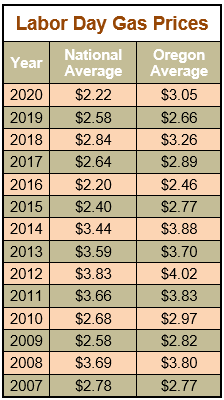
Retail gas prices have been inching down but some areas could see temporary spikes following Hurricane Ida and ahead of the Labor Day holiday weekend. The storm has taken about 13% of U.S. refining capacity offline. Impacts should be minimal here on the West Coast. For the week, the national average for regular ticks up a penny to $3.16 a gallon. The Oregon average slips a penny to $3.78.
“Drivers will pay the most expensive prices for gas over the Labor Day holiday in seven years. Most Labor Day travelers are going by car, which has been the most popular way to travel during the coronavirus pandemic,” says Marie Dodds, public affairs director for AAA Oregon/Idaho.

With COVID-19 cases surging in Oregon and most other states, and schools already back in session or starting soon, travel is not expected to be as robust this Labor Day as before the pandemic. For those who do choose to take a trip on the last holiday weekend of the summer, many are visiting destinations that are fairly close—about a day’s drive—from home.
Here are the top 10 destinations for Labor Day based on bookings and searches at AAA.com/travel over the past 30 days:
- Oregon coast: Lincoln City, Seaside, Newport, Florence, Cannon Beach
- Bend
- Las Vegas
- Washington: Seattle, Walla Walla
- Northern/Central California: Redding, Eureka, Sacramento, Monterey, San Luis Obispo
- Yellowstone National Park and surrounding areas including Wyoming and Montana
- Portland
- Ashland, OR
- Utah: Ogden, Moab
- Anaheim, Disneyland
Visit AAA.com/covidmap for an interactive map with the latest travel restrictions and policies for North America. Find AAA’s latest COVID-19 information for travelers here.
Travelers also need to monitor wildfires in the west and stay informed about closures and evacuations.
There were nine oil refineries in Ida’s path; at least six shut down operations ahead of the storm. Power outages are widespread across Louisiana and Mississippi. About 15% of the nation’s oil comes from the Gulf of Mexico.
“Once power is restored, it will take some time to determine the full impact of any damage Ida caused to the oil and gas industry in and near the Gulf of Mexico. Drivers can expect price fluctuations leading up the Labor Day weekend, especially in the Southeast and East Coast,” says Marie Dodds, public affairs director for AAA Oregon/Idaho.
Typically, a category 4 storm could mean three plus weeks before refineries and other facilities are inspected and return to normal operations, while offshore production is more likely to resume this week.
Gasoline demand is up slightly to nearly 9.6 million b/d, according to the U.S. Energy Information Administration. That’s the second-highest demand reading this year, trailing only the 10 million b/d reading ahead of the July 4th holiday, but still about 3% below the same week in August 2019.
Quick stats
Oregon is one of 23 states with lower prices now than a week ago. All states are showing small changes of a nickel or less this week. North Dakota (-3 cents) has the largest weekly drop in the country. Indiana (+5 cents) has the largest week-over-week gain. Averages are flat in Kansas and Montana.
California ($4.40), Hawaii ($4.07), and Nevada ($4.03) continue to have the most expensive gas prices in the country and are the only states in the nation with averages above $4 a gallon, and 31 states and the District of Columbia are at or above $3, same as a week ago.
The cheapest gas in the nation is in Texas ($2.78) and Mississippi ($2.78). For the 34th week in a row, no state has an average below $2 a gallon.
Oregon is one of 22 states with higher prices now than a month ago. The national average is one cent less and the Oregon average is five cents more than a month ago. This is the fifth-largest month-over-month increase in the nation. Colorado (+6 cents) has the largest monthly increase in the country. Delaware (-10 cents) has the largest month-over-month decrease.
All 50 states and the District of Columbia have higher prices now than a year ago, and 13 states including Oregon have a current average that’s a dollar or more higher than a year ago. The national average is 93 cents more and the Oregon average is $1.11 more than a year ago. This is the eighth-largest yearly increase in the nation. Utah (+$1.39) has the biggest yearly increase. Delaware (+69 cents) has the smallest year-over-year increase.
West Coast
The West Coast region continues to have the most expensive pump prices in the nation with every state in the region except Arizona in the top 10.
| Rank | Region | Price on 8/31/21 | ||
| 1 | California | $4.40 | ||
| 2 | Hawaii | $4.07 | ||
| 3 | Nevada | $4.03 | ||
| 4 | Washington | $3.90 | ||
| 5 | Utah | $3.82 | ||
| 6 | Idaho | $3.80 | ||
| 7 | Oregon | $3.78 | ||
| 8 | Alaska | $3.70 | ||
| 9 | Colorado | $3.62 | ||
| 10 | Wyoming | $3.59 |
California is the most expensive state for the 32nd week in a row with Hawaii, Nevada and Washington rounding out the top four. Oregon is seventh, Alaska is eighth and Arizona is 20th. Oregon is seventh for the sixth week in a row.
All seven states in the West Coast region are among the 31 states in the country that have averages above $3 a gallon.
Pump prices in the West Coast region are showing small changes this week, like most other regions. Nevada (-2 cents) has the largest weekly decline in the region, while California (+1 cent) has the biggest weekly increase.
The refinery utilization rate has increased in the West Coast region this week from 87% to 88.5%. The rate has been between 85% and 88% much of the summer after remaining between about 82% and 84% this spring.
According to EIA’s latest weekly report, total gas stocks in the region are fairly steady, going from 29.34 million bbl to 29.30 million bbl.
Oil market dynamics
Crude oil prices rose last week as production ramped down ahead of Hurricane Ida making landfall. As the storm battered the Southeast, more than 95% of oil production in the Gulf Coast region was shuttered. In addition, the federal Bureau of Safety and Environmental Enforcement reports that 288 out of 560 manned offshore platforms were evacuated; all 11 of the non-dynamically positioned rigs have been evacuated; and 10 of the 15 dynamically positioned rigs were moved out of the storm’s path as a precaution. For this week, crude prices will likely increase, at least temporarily, in response to reduced supply. However, as the storm clears and damage is assessed, production will gradually return to normal operations and help to stabilize prices as supply increases.
At the close of Friday’s formal trading session, WTI increased by $1.32 to settle at $68.74. At the close of Monday’s formal trading session, WTI added 47 cents to settle at $69.21. Today crude is trading around $69, compared to $67 a week ago. Crude prices are about $26 more than a year ago.
Drivers can find current gas prices along their route with the free AAA Mobile app for iPhone, iPad and Android. The app can also be used to map a route, find discounts, book a hotel and access AAA roadside assistance. Learn more at AAA.com/mobile.















